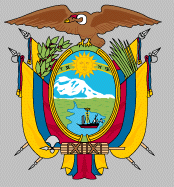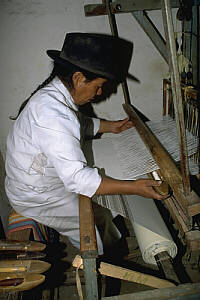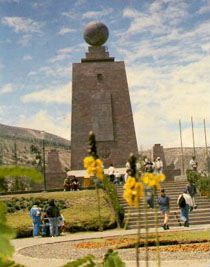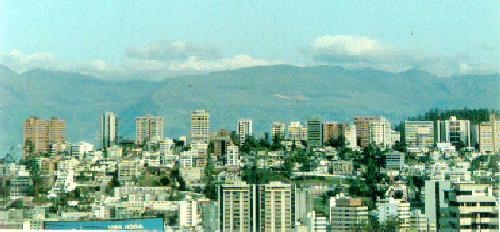 Great Seal of Ecuador
Great Seal of Ecuador
 Great Seal of Ecuador
Great Seal of Ecuador
Out of the chasm of time rose the Indians. No one knows for certain where they came from. Perhaps they slid over the ice from Siberia or crossed the Pacific by frail rafts. They settled firmly into the jungles.
In 1455 the Incas began their expansion. The northern half of the Inca Empire was located in Ecuador, with Quito as its capital. In Ecuador they reorganized the local Indian life. The Inca tongue of Quechua was taught as the state language. The Inca introduced their religion, their temples, their priests, their many fiestas and liturgies. And, although Inca sun worship was the official religion, the Inca influence was more material than spiritual. Magnificent roads were built. The Emperor supplied food and clothing in case of famine or disaster. But the wonderful organization and great expanse of the Incas were doomed to extinction. The Spanish conquistadores came in search of gold and glory.
Spain ended for all time the Indian rule of the Andes. Two hundred thousand Spaniards conquered all of South America and its 30 million Indians. For nearly 300 years Spain ruled. They ravaged, prayed and governed. The Indians fled higher and higher into the cloud-swept mountains or down to the jungles, while Spain built monasteries and palaces.

Quechua Indian at Work Weaving
In the highlands of Ecuador, an Otavaleño weaver works at a treadle loom, producing a woolen rug of rich greys, creamy white and rust-red. The Otavalo weaving tradition stretches unbroken from even before the Inca armies marched into their Andean mountain valley homeland in 1455. The Incas introduced the llama, and llama wool was soon widely adopted by Otavalo weavers along with the cotton upon which they had relied. Although the Incas never completely conquered the Otavaleños prior to being themselves conquered by the Spaniards, their language, Quechua, was adopted as the native tongue. About a century later the Spanish took control of the Otavalo region, and introduced the treadle loom pictured here, as well as sheep's wool. As the cash economy supplanted their traditional ways, the weaving industry became central to the region's economy and helped the Otavalenos retain some degree of autonomy. However, in the 19th century the industrial revolution allowed the mass production of cheap cloth, and the Otavalo weaving industry was severely impacted. But rather than dissappear, the Otavaleño weavers returned to their roots and today their art thrives anew, based upon their quality handcrafting.
The Spanish conquistadors conquered the Incas in Ecuador in 1532. Although, the city of Quito had long existed in Indian legend and lore, and was the capital of the Northern Inca Empire, the Spanish founding was much later in 1534. In 1563 this area was a Royal Audencia of Spain with its seat in Quito.
In the early 1800's revolutions blazed like torches all over South America and the Spanish dominion collapsed. In 1822 Simón Bolívar and his fighting general, Jose Antonio Sucre, freed Ecuador from Spain. The new Republic seceded from Gran Colombia in 1830, and adopted the political pattern of the U. S. and France while maintaining norms of social paternalism from the old Spanish order.
CAPITAL: Quito
LANGUAGE: Spanish is the official language. Quechua, the language of the Incas, is the most important Indian tongue.
GOVERNMENT: Republic
HEAD OF STATE: President
AREA: 109,484 sq. mi., including the Galapagos Island. Ecuador is about the size of Arizona.
ELEVATION: The highest elevation is Mt. Chimborazo which is a volcano at 20,561 feet above sea level. The lowest is at sea level.
POPULATION: 10,800,000
INDEPENDENCE DAY: August 10
MONEY: Sucre. One hundred centavos equals one Sucre.
Guayaquil is Ecuador's largest city and is located near the Pacific coast. It is tropical. It is the commercial, industrial and financial hub of the coast.
The Oriente jungle region comprises half of the land mass of the country. Here live the Colorado, Jívaro, Auca, Cayapa, Cofán, and Secoya. Also, rich oil deposits are found in these jungle rain forests.
The Galápagos Islands, located 500 miles offshore, belong to Ecuador. They number about 60 and are sparsely inhabited. Their fame rests on their wildlife. Here tortoises live for hundreds of years, and weigh in at a quarter of a ton.
Quito, the Light of the Americas, is located at latitude zero. It sits just ten miles south of the line of the Equator, yet its average temperature is 57 F year round. The temperatures usually range from around 50 in the morning and night, and rise to around 70 during the day. The ancient capital of the New World sits at 9,600 feet above sea level. Quito is the second-highest capital in the Americas. Ecuador has no fewer than 22 mountains between two and a half and four miles high. Cotopaxi is 19,344 feet above sea level, and Chimborazo is 20,577 feet. On a clear day in Quito you can see six snow-capped mountain peaks in the distance.
Ecuadorians are fond of saying that when God created the world He left His finger just a little bit longer on Ecuador. It is truly the land of eternal springtime, and the "Switzerland of South America." Lofty mountains stands over the rolling, peaceful Sierra countryside; deep-river valleys borders virgin forest; tropical plains and ocean shores blend together.

Equator Monument ten miles north of Quito.
Latitude "0." "The oldest capital in the New World." "The highest active volcano in the world." These are common expressions often used to describe the rare beauty and contrast of Quito, one of the most beautiful capitals in the Western Hemisphere.
Ecuador straddles the Equator on the Pacific coast of South America, is bounded by Colombia on the North and Peru on the South and east.
Middle and upper class Ecuadorians value literary, artistic and intellectual pursuits.
Soccer, basketball and volleyball are leading sports.
Ecuador's educational system is tuition free and mandatory from ages 6 through 14.
Ecuador is the world's largest exporter of bananas and shrimp. It also exports oil from the Oriente fields 300 miles across the high rugged Andes mountains to the oil port at Esmeraldas on the Pacific Coast. Most of the oil is exported to the U. S.
It also has huge hydroelectric power plants in the Andes.
Agriculture remains the mainstay of Ecuador's domestic economy. Principal export crops are bananas, coffee, cacao and sugar. The most important domestic food crops are corn, rice, barley and potatoes.
Major manufacturing industries include food processing, textiles, leather products, paper products, wood and furniture and household appliances.

City of Quito
The Gospel of Jesus Christ first arrived in Ecuador with the coming of a Bible Society representative selling Bibles and New Testaments along the coastal ports of South America, including Guayaquil. The first Protestant mission to begin work in Ecuador was the Gospel Missionary Union in 1896. The next year the Christian and Missionary Alliance began work there. Missionary Radio Station HCJB, "The Voice of the Andes," began its first broadcast at 4:00 PM on Christmas Day in 1931. Its first studio was a converted sheep shed. Can you think of a more appropriate place to proclaim the "lamb of God shed for the sins of the world"?
The Ecuadorian Baptist Convention was organized in October 1972. Trained Ecuadorian leaders are emerging. Since 1982 missionaries and Ecuadorian leaders have been working toward a unified program of work administered by the Ecuadorian convention. The Ecuadorians have several home missionary couples. In 1984, the convention adopted a goal of 2.5 million church members by A .D. 2000.
Recent highlights: Ecuadorian Baptists and 165 Southern Baptist volunteers from the United States shared in partnership evangelism crusades in several communities. More than 1,000 people made professions of faith in Jesus Christ. One group of the volunteers started missions work in a new place and that work continues. Several new congregations were recently started, several churches and buildings were constructed and several churches made additions to their buildings. Ecuador Baptist churches in 1989 attained a ratio of one baptism for every 7.36 church members.
Local Baptists in a four-month period made 461 personal contacts as follow-up to radio and television programs. One out of every four persons contacted made the decision to follow Christ. Some of the programs were in the Quechua Indian language.
Enrollment in the Baptist Theological Seminary has increased. Four of the 57 students finished their work on a degree. Seminary students work with Southern Baptist missionaries, and national home missionaries when not attending classes. The students have participated in evangelistic campaigns and revivals. Several local associations have conducted training sessions in religious education and workshops for Sunday School teachers.
The convention's periodical El Mensajero Bautista is published regularly. A prayer calendar for churches and a prayer booklet for a nationwide week of prayer were published recently.
Ecuadorian Baptists have conducted nutrition and health care workshops in numerous locations. Volunteer medical groups from the U.S. have helped Ecuadorians minister in some situations with special needs. In one project in the city of Calderon, dentists and doctors treated l,400 patients.
A Baptist center begun in 1987 at Puyo has served the area with a program of varied ministries. It still struggles toward self support. At a training center in Tambo, demonstration plots to teach farming have been planted. A hunger relief project in Shushufindi teaches courses in carpentry, baking and sewing.
It is wonderful being involved in something that will still be worthwhile a million years from now!
Give Us Your Feedback - Immediate Response Form - Only takes a couple of seconds Also best way to email us.
Radio HCJB. The Voice of the Andes
International Mission Board, SBC
EL COMERICO Newspaper, Quito, Ecuador
EL UNIVERSO Newspaper, Guayaquil, Ecuador
Ecuador on Internet Try some these sites for additional information.
Back to ABIDE IN CHRIST Home Page
ABIDE IN CHRIST LINKS Great resources for living the Christian life. Selected links from around the world.
|
Teams in Action Reports with Wil and Ann Pounds from Honduras
Who are we?
Recent Team Reports:
Lepaterique
Esquias
San
Francisco |